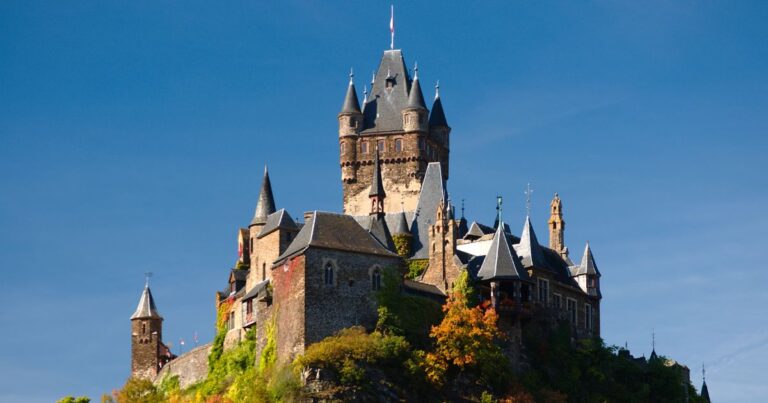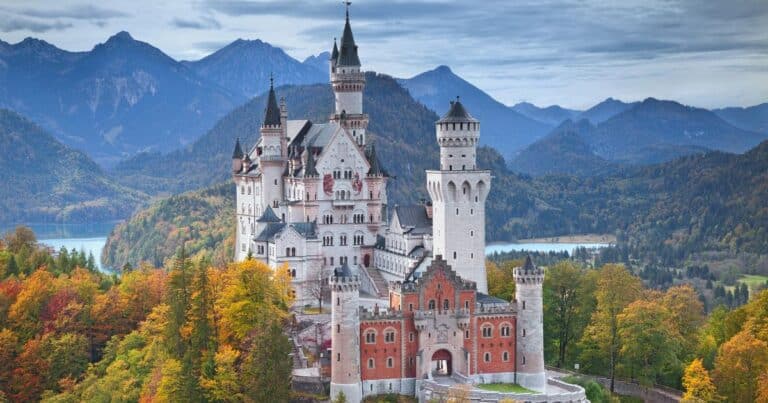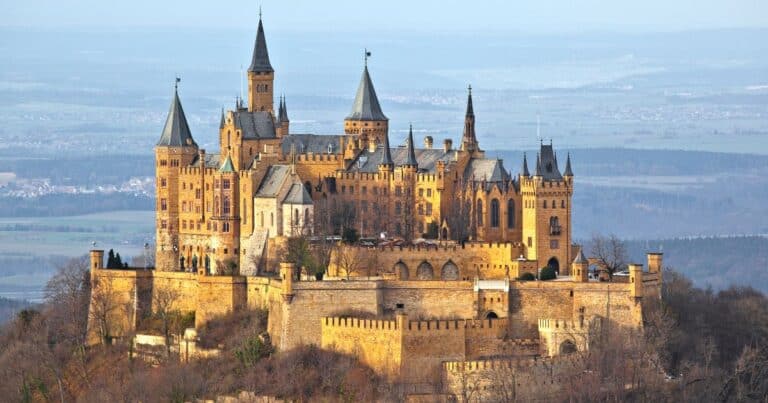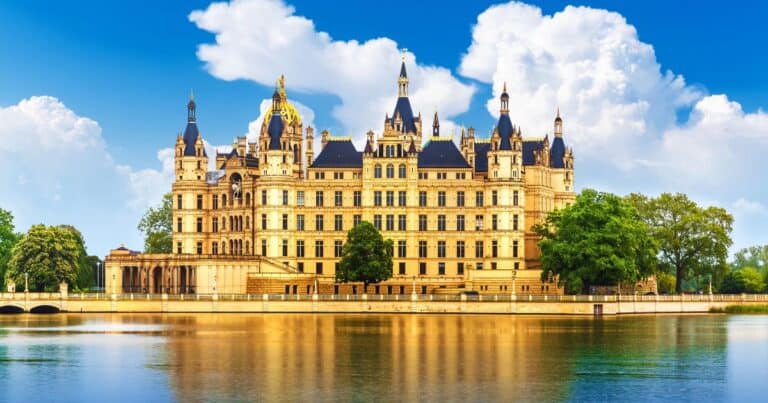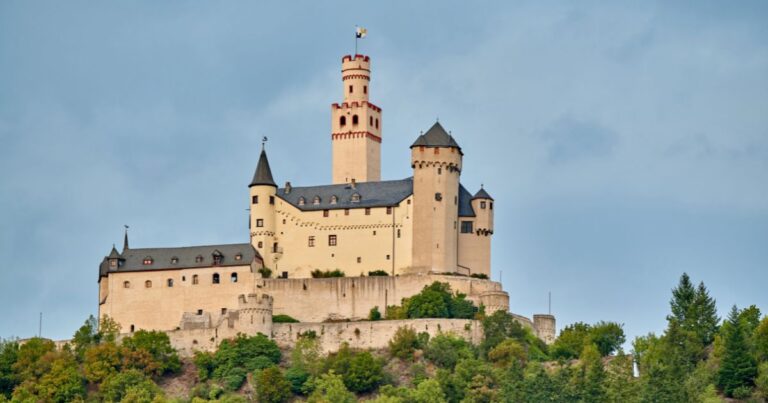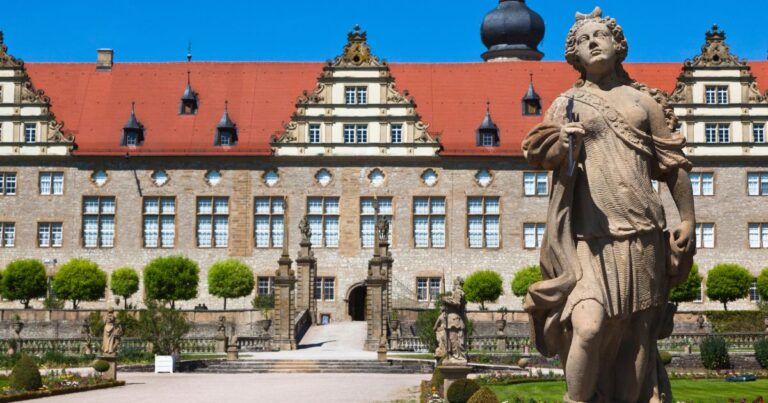Sanssouci Palace Guide: Inside Frederick the Great’s Prussian Masterpiece

If Neuschwanstein is Germany’s fairy-tale palace, Sanssouci Palace is its elegant soul. Designed in the 1740s as a private refuge for King Frederick the Great, this jewel-box Rococo palace sits atop terraced vineyards overlooking Potsdam. Intimate, ornate, and full of personality, Sanssouci remains one of Europe’s most enchanting royal residences.
With 40+ years in the travel industry and decades spent exploring Europe’s palaces, castles, and UNESCO sites, I’ve walked these gilded rooms many times. This guide blends historical context, practical tips, architectural insights, and expert recommendations to help you plan a smooth and memorable visit.
Historical Snapshot
- Location: Potsdam, Brandenburg, Germany
- Built: 1745–1747
- Architect: Georg Wenzeslaus von Knobelsdorff
- Built For: Frederick the Great, King of Prussia
- Style: Rococo
- UNESCO Status: Part of the Palaces and Parks of Potsdam and Berlin
- Best For: Palace lovers, architecture fans, garden enthusiasts, Prussian history buffs
Planning a broader trip through the region?
Explore more historic sites on our German Castles Page.
Table of Contents
Historical Overview

Perched on a terraced vineyard overlooking the sweeping landscape of Potsdam, Sanssouci Palace (“without care”) was Frederick the Great’s personal haven — a place to read, study, discuss philosophy, and host intimate gatherings of his closest friends.
If you’re interested in exploring more historic fortresses across the country, visit our full Castles in Germany Guide.
Frederick supervised every detail of the palace’s construction, working closely with architect Georg Wenzeslaus von Knobelsdorff to craft a residence inspired by French Rococo but infused with Frederick’s own tastes.
Originally a single-story, ten-room palace, Sanssouci was complemented by grand gardens, sweeping promenades, fountains, temples, and later, additional palaces such as the New Palace, Charlottenhof, and the Orangery – all part of the sprawling Sanssouci Park.
Today, Sanssouci remains remarkably preserved, with many rooms exactly as Frederick left them – a rare glimpse into the intimate world of an 18th-century monarch.
If you’re also exploring Germany’s most significant royal residences, you may enjoy visiting Hohenzollern Castle – one of the country’s most impressive historic fortresses.
Beyond its beauty, Sanssouci also became a political and intellectual hub. Frederick invited musicians, artists, and Enlightenment thinkers to the palace, using its quiet atmosphere to engage in conversations about philosophy, literature, and governance. Although Frederick ruled a militaristic kingdom, Sanssouci reveals a different side of him – the poet, the musician, the thinker who valued reason over ceremony.
During Frederick’s lifetime, the palace grounds evolved continuously as he experimented with new architectural ideas and garden layouts. Later monarchs added structures such as the New Palace and Charlottenhof, transforming the landscape into a vast network of palaces and gardens that today make up the world-famous Sanssouci Park.
Architectural and Design Highlights
Sanssouci is small by royal standards – but perfect by Frederick’s. It’s a masterclass in elegant Rococo design.
The Vineyard Terraces
The palace crowns a series of vineyard terraces supported by sandstone walls and lined with carefully trained vines. From the top, the view stretches across Sanssouci Park toward the city of Potsdam.
The Rococo Façade
Curved windows, playful ornamentation, gilded details, and the palace’s bright yellow coloring give the exterior its iconic sunny look.
The Marble Hall
The central domed hall, modeled after Roman temples, features Corinthian columns, marble statues, and views over the vineyard terraces.
The Music Room
Frederick was an accomplished flutist, and this room hosted his intimate concerts. Gilded carvings and mirrored walls make it one of the palace’s most beautiful spaces.
The Voltaire Room
Named for Frederick’s famous guest – philosopher Voltaire – this room glitters with ornate wood carvings of fruits, flowers, and exotic birds.
The Library
Frederick’s private refuge, filled with red lacquered bookcases and his personal collection of classical works.
Frederick’s Private Apartments
Modest yet refined, they reflect his preference for simplicity, intellectual pursuits, and quiet living.
Inside Sanssouce Palace: What You’ll See

Sanssouci’s interiors remain among the most authentic in Europe, thanks to careful preservation and Frederick’s original furnishings.
The Entrance Hall
A beautifully symmetrical introduction to the palace, decorated with marble columns and classical motifs.
The Marble Hall
The heart of Sanssouci – a glowing, elegant space used for receptions and gatherings.
The Audience Room
Where Frederick received close friends, scholars, and favored guests.
The Bedroom
Frederick’s simple but refined sleeping quarters – surprisingly austere compared to the rest of the palace.
The Study
Filled with books, portraits, and a sense of quiet introspection.
The Voltaire Room
One of the most photographed rooms in Germany, bursting with vibrant color and exquisite carved details.
The Gallery
Featuring works by Rubens, Van Dyck, and other major European artists.
The Pastries Room
A charming space showcasing tableware and silver used for Frederick’s small gatherings.
The Palace Kitchens
Located in adjacent outbuildings; these give insight into how elaborate meals were prepared for royal guests.
Taken together, these rooms create an intimate portrait of Frederick’s daily life. Unlike the sprawling palaces of Vienna or Paris, Sanssouci feels deeply personal – almost as though the king has only briefly stepped out for a walk among the terraces. The preservation of original furnishings, artwork, and architectural details makes the palace one of Europe’s most authentic time capsules of the Enlightenment era.
For those interested in a more medieval counterpart to Sanssouci’s refined Rococo interiors, Marksburg Castle offers one of Germany’s most authentic fortress layouts, preserved exactly as it stood centuries ago.
Sanssouci Park: The Gardens and Surrounding Structures
The palace may be intimate, but Sanssouci Park is vast. Highlights include:
The Great Fountain
At the foot of the vineyard terraces – the dramatic focal point of the main garden axis.
The Orangery Palace
A long Renaissance-inspired building used to house exotic plants in winter.
The New Palace
A monumental Baroque residence built by Frederick later in life – a striking contrast to Sanssouci’s intimacy.
The Neptune Grotto
A decorative garden feature inspired by ancient mythology.
The Chinese House
A whimsical Rococo pavilion with gilded statues and a circular colonnade.
The Roman Baths
An architectural fantasy blending classical motifs, gardens, and tranquil water features.
You could spend a full day wandering the park and still not see everything.
Even beyond these major highlights, the park is filled with hidden pathways, quiet lawns, small pavilions, and romantic viewpoints scattered throughout its miles of landscaped grounds. Benches tucked beneath ancient trees offer peaceful places to rest, while long tree-lined avenues lead visitors between palaces. It’s easy to spend an entire afternoon wandering without retracing your steps, which is why many travelers return more than once during their Potsdam stay.
Notable Figures and Events
These are some historically significant figures and events tied to Sanssouci:
- Frederick the Great – Philosopher-king, musician, military leader, and the palace’s creator.
- Voltaire – Lived at Sanssouci during their famously complex friendship.
- Georg W. von Knobelsdorff – Architect who translated Frederick’s vision into reality.
- Seven Years’ War (1756–1763) – Frederick often retreated here during political tension.
- UNESCO Designation (1990) – Recognized the palace and park as a cultural masterpiece.
Legendary Tales and Local Lore
While Sanssouci is not a “haunted” palace, it does inspire stories:
Frederick’s Midnight Walks
Some say the king’s soft flute music can be imagined on quiet evenings in the gardens.
Voltaire’s Laughter in the Voltaire Room
Guides sometimes mention the lingering energy of their sharp-tongued debates.
The Tomb on the Vineyard Terrace
Frederick’s wish was to be buried on the terrace among his dogs – and today, visitors leave potatoes on his grave (his favorite food).
Why Visit Sanssouci Palace
Sanssouci is unlike any other royal residence in Germany:
- An exquisitely preserved example of Prussian Rococo, created as Frederick’s personal retreat.
- Intimate rooms full of original furnishings, paintings, and decorative arts.
- World-class gardens stretching for miles – perfect for leisurely strolling.
- A UNESCO World Heritage Site visited by millions but still peaceful in the early hours.
- One of Europe’s best combinations of architecture, art, landscape design, and royal biography.
If you want to explore where a king lived, wrote poetry, played music, and escaped the formality of Berlin court life – Sanssouci is the place.
Visiting Sanssouci Palace Today: What To Expect
A visit to Sanssouci is a seamless blend of art, history, and scenic wandering.
Highlights of a Visit
- Entry to the palace is timed; advance reservations highly recommended.
- Audio guides provide excellent context.
- The palace interior takes about 30–45 minutes to visit.
- The park alone can take hours – wear comfortable shoes.
- Don’t miss the vineyard terraces and views toward Potsdam.
Photography
Interior photography is limited or restricted in many rooms – rules vary by season.
Accessibility
Some areas have steps and uneven historic flooring; accessibility varies throughout the complex.
If you’re planning to visit multiple buildings in Sanssouci Park, consider setting aside at least half a day. The distances between palaces can be longer than they appear on maps, and paths often wind through hilly terrain. Many visitors pair Sanssouci with the New Palace in one outing and leave the Chinese House and Roman Baths for a second, more leisurely visit.
Getting There
Closest Major City: Berlin (40 minutes)
By Train: From Berlin to Potsdam; local bus or 20-minute walk to the palace
By Car: Paid parking available near Sanssouci Park
By Tour: Many Berlin day tours include Sanssouci as a highlight
By Bike: A popular option — scenic routes connect Berlin and Potsdam
Visitor Information
Hours, ticket details, and seasonal schedules can change – be sure to double-check the official website before planning your visit.
Hours
- Open year-round with seasonal variations
- Extended hours in summer
- Reduced hours in winter
- Holiday closures possible
Always check the official site before visiting.
Admission
- Timed palace entry
- Combined park + palace tickets available
- Discounts for students, families, seniors
Accessibility
- Uneven paths throughout the gardens
- Some interior areas require steps
- Limited accessibility inside the palace
Nearby Attractions
If you’re visiting Sanssouci, you’re surrounded by treasures:
- New Palace – Frederick’s grandest residence
- Charlottenhof Palace – An elegant neoclassical villa
- Orangery Palace – Renaissance-inspired with tropical plants
- Chinese House – A charming Rococo garden pavilion
- Historic Windmill of Sanssouci – Iconic landmark beside the palace
- Potsdam Old Town – Cafés, boutiques, and historic squares
- Glienicke Bridge – The famous “Bridge of Spies”
Frequently Asked Questions About Sanssouci Palace
Is Sanssouci Palace worth visiting?
Absolutely – it’s one of Europe’s most beautiful Rococo palaces and a UNESCO World Heritage treasure.
How long does a visit take?
Plan 2–4 hours depending on how much of the park you explore.
Do I need advance tickets?
Yes. Timed entry sells out quickly, especially in summer.
Is the Palace accessible for those with mobility issues?
Somewhat, but not fully – narrow halls and steps can be challenging.
What is the best time of year to visit?
Spring and early autumn offer ideal weather and beautiful gardens.
Conclusion
Sanssouci Palace is more than a royal residence – it’s a glimpse into the private world of Frederick the Great, filled with music, philosophy, art, and breathtaking design. Whether you’re a palace aficionado, a garden lover, or a traveler exploring the Berlin-Potsdam region, a visit to Sanssouci provides a peaceful and unforgettable look at Prussian history.
If you’re continuing your journey through Germany’s royal landmarks, both Hohenzollern Castle and Marksburg Castle make excellent next stops.

